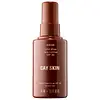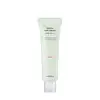What's inside
What's inside
 Key Ingredients
Key Ingredients

 Benefits
Benefits

 Concerns
Concerns

 Ingredients Side-by-side
Ingredients Side-by-side

Butyl Methoxydibenzoylmethane 3%
UV AbsorberEthylhexyl Salicylate 5%
UV AbsorberOctocrylene 10%
UV AbsorberWater
Skin ConditioningButyloctyl Salicylate
Skin ConditioningSodium Potassium Aluminum Silicate
Diisopropyl Sebacate
EmollientDiisopropyl Adipate
EmollientC12-15 Alkyl Benzoate
AntimicrobialLauryl Lactate
EmollientGlycerin
HumectantMica
Cosmetic ColorantPropanediol
SolventGlyceryl Stearate
EmollientCitrullus Lanatus Fruit Extract
Skin ConditioningPyrus Malus Fruit Extract
Skin ConditioningLens Esculenta Fruit Extract
Skin ConditioningChondrus Crispus Extract
Skin ConditioningPanthenol
Skin ConditioningNiacinamide
SmoothingFerulic Acid
AntimicrobialHelianthus Annuus Seed Oil
EmollientTheobroma Cacao Seed Butter
EmollientCetyl Phosphate
EmulsifyingGlyceryl Stearate Citrate
EmollientSilica
AbrasiveCaprylyl Glycol
Emollient1,2-Hexanediol
Skin ConditioningAcrylates/C10-30 Alkyl Acrylate Crosspolymer
Emulsion StabilisingChlorphenesin
AntimicrobialAminomethyl Propanol
BufferingDisodium EDTA
Sodium Lactate
BufferingSodium PCA
HumectantVanilla Planifolia Fruit Extract
Skin ConditioningSantalum Album Oil
MaskingRosa Damascena Flower Oil
MaskingMyroxylon Pereirae Oil
MaskingCupressus Sempervirens Leaf/Nut/Stem Oil
EmollientCoffea Arabica Seed Oil
MaskingCitrus Aurantium Bergamia Fruit Oil
MaskingCitrus Aurantium Amara Flower Oil
MaskingAmyris Balsamifera Bark Oil
MaskingSodium Benzoate
MaskingPotassium Sorbate
PreservativeCaprylic/Capric Triglyceride
MaskingLimonium Gerberi Extract
Skin ProtectingLimonene
PerfumingLinalool
PerfumingBenzyl Benzoate
AntimicrobialTitanium Dioxide
Cosmetic ColorantIron Oxides
Butyl Methoxydibenzoylmethane 3%, Ethylhexyl Salicylate 5%, Octocrylene 10%, Water, Butyloctyl Salicylate, Sodium Potassium Aluminum Silicate, Diisopropyl Sebacate, Diisopropyl Adipate, C12-15 Alkyl Benzoate, Lauryl Lactate, Glycerin, Mica, Propanediol, Glyceryl Stearate, Citrullus Lanatus Fruit Extract, Pyrus Malus Fruit Extract, Lens Esculenta Fruit Extract, Chondrus Crispus Extract, Panthenol, Niacinamide, Ferulic Acid, Helianthus Annuus Seed Oil, Theobroma Cacao Seed Butter, Cetyl Phosphate, Glyceryl Stearate Citrate, Silica, Caprylyl Glycol, 1,2-Hexanediol, Acrylates/C10-30 Alkyl Acrylate Crosspolymer, Chlorphenesin, Aminomethyl Propanol, Disodium EDTA, Sodium Lactate, Sodium PCA, Vanilla Planifolia Fruit Extract, Santalum Album Oil, Rosa Damascena Flower Oil, Myroxylon Pereirae Oil, Cupressus Sempervirens Leaf/Nut/Stem Oil, Coffea Arabica Seed Oil, Citrus Aurantium Bergamia Fruit Oil, Citrus Aurantium Amara Flower Oil, Amyris Balsamifera Bark Oil, Sodium Benzoate, Potassium Sorbate, Caprylic/Capric Triglyceride, Limonium Gerberi Extract, Limonene, Linalool, Benzyl Benzoate, Titanium Dioxide, Iron Oxides
Water
Skin ConditioningAlcohol
AntimicrobialDiethylamino Hydroxybenzoyl Hexyl Benzoate
UV FilterBis-Ethylhexyloxyphenol Methoxyphenyl Triazine
Skin ConditioningButyloctyl Salicylate
Skin ConditioningDibutyl Adipate
EmollientEthylhexyl Triazone
UV AbsorberHexyl Laurate
EmollientNiacinamide
SmoothingPolymethylsilsesquioxane
Caprylyl Methicone
Skin ConditioningSodium Acrylates Crosspolymer-2
AbsorbentChlorella Minutissima Extract
Skin ConditioningBeta Vulgaris Root Extract
Skin ConditioningIsoamyl P-Methoxycinnamate
UV AbsorberPolysilicone-15
UV Filter1,2-Hexanediol
Skin ConditioningPentylene Glycol
Skin ConditioningButylene Glycol
HumectantGlucose
HumectantSodium Polyacryloyldimethyl Taurate
Emulsion StabilisingHydroxyacetophenone
AntioxidantPolyacrylate Crosspolymer-6
Emulsion StabilisingFructooligosaccharides
HumectantFructose
HumectantEthylhexyl Olivate
Skin ConditioningSodium Acrylates Copolymer
Polyglyceryl-4 Oleate
EmulsifyingAdenosine
Skin ConditioningEthylhexylglycerin
Skin ConditioningDisodium EDTA
Water, Alcohol, Diethylamino Hydroxybenzoyl Hexyl Benzoate, Bis-Ethylhexyloxyphenol Methoxyphenyl Triazine, Butyloctyl Salicylate, Dibutyl Adipate, Ethylhexyl Triazone, Hexyl Laurate, Niacinamide, Polymethylsilsesquioxane, Caprylyl Methicone, Sodium Acrylates Crosspolymer-2, Chlorella Minutissima Extract, Beta Vulgaris Root Extract, Isoamyl P-Methoxycinnamate, Polysilicone-15, 1,2-Hexanediol, Pentylene Glycol, Butylene Glycol, Glucose, Sodium Polyacryloyldimethyl Taurate, Hydroxyacetophenone, Polyacrylate Crosspolymer-6, Fructooligosaccharides, Fructose, Ethylhexyl Olivate, Sodium Acrylates Copolymer, Polyglyceryl-4 Oleate, Adenosine, Ethylhexylglycerin, Disodium EDTA
 Reviews
Reviews

Ingredients Explained
These ingredients are found in both products.
Ingredients higher up in an ingredient list are typically present in a larger amount.
1,2-Hexanediol is a synthetic liquid and another multi-functional powerhouse.
It is a:
- Humectant, drawing moisture into the skin
- Emollient, helping to soften skin
- Solvent, dispersing and stabilizing formulas
- Preservative booster, enhancing the antimicrobial activity of other preservatives
Butyloctyl Salicylate is a chemical UV filter structurally similar to octisalate. It is a photostabilizer, SPF booster, emollient and solvent. This ingredient helps evenly spread out ingredients.
According to a manufacturer, it is suitable for pairing with micro Titanium Dioxide, Zinc Oxide, and pigments.
Photostabilizers help stabilize UV-filters and prevents them from degrading quickly.
Learn more about Butyloctyl SalicylateDisodium EDTA plays a role in making products more stable by aiding other preservatives.
It is a chelating agent, meaning it neutralizes metal ions that may be found in a product.
Disodium EDTA is a salt of edetic acid and is found to be safe in cosmetic ingredients.
Learn more about Disodium EDTANiacinamide is a multitasking form of vitamin B3 that strengthens the skin barrier, reduces pores and dark spots, regulates oil, and improves signs of aging.
And the best part? It's gentle and well-tolerated by most skin types, including sensitive and reactive skin.
You might have heard of "niacin flush", or the reddening of skin that causes itchiness. Niacinamide has not been found to cause this.
In very rare cases, some individuals may not be able to tolerate niacinamide at all or experience an allergic reaction to it.
If you are experiencing flaking, irritation, and dryness with this ingredient, be sure to double check all your products as this ingredient can be found in all categories of skincare.
When incorporating niacinamide into your routine, look out for concentration amounts. Typically, 5% niacinamide provides benefits such as fading dark spots. However, if you have sensitive skin, it is better to begin with a smaller concentration.
When you apply niacinamide to your skin, your body converts it into nicotinamide adenine dinucleotide (NAD). NAD is an essential coenzyme that is already found in your cells as "fuel" and powers countless biological processes.
In your skin, NAD helps repair cell damage, produce new healthy cells, support collagen production, strengthen the skin barrier, and fight environmental stressors (like UV and pollution).
Our natural NAD levels start to decline with age, leading to slower skin repair, visible aging, and a weaker skin barrier. By providing your skin niacinamide, you're recharging your skin's NAD levels. This leads to stronger, healthier, and younger looking skin.
Another name for vitamin B3 is nicotinamide. This vitamin is water-soluble and our bodies don't store it. We obtain Vitamin B3 from either food or skincare. Meat, fish, wheat, yeast, and leafy greens contain vitamin B3.
The type of niacinamide used in skincare is synthetically created.
Learn more about NiacinamideWater. It's the most common cosmetic ingredient of all. You'll usually see it at the top of ingredient lists, meaning that it makes up the largest part of the product.
So why is it so popular? Water most often acts as a solvent - this means that it helps dissolve other ingredients into the formulation.
You'll also recognize water as that liquid we all need to stay alive. If you see this, drink a glass of water. Stay hydrated!
Learn more about Water